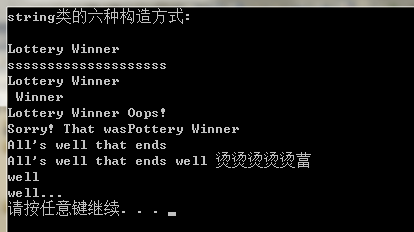在c++中string类的构造函数有六种方式
分别是:
1.string(const char * s)
说明:将string对象初始化为s指向NBTS。NBTS为null-byte-temnated string的缩写,表示以空字符结束的字符串------传统的C字符串。
2.string(size_type n,char c)
说明:创建一个包含n个元素的string对象,其中每个元素都被初始化为字符c
3.string(const string & str,string size_type n = npos)
说明:将string对象初始化为对象str中从位置pos开始到结尾的字符,或从位置pos开始的n个字符
4.string()
说明:创建一个的string对象,长度为0
5.string(const char * s, size_type n)
说明:将string对象初始化为s指向的NBTS中的前n字符,即使超过了NBTS端
6.template<clas Iter> string(Iter begin,Iter end)
说明:将string对象初始化为区间[begin,end]内的字符,其中begin和end的行为就像指针,用于指定位置,范围包括begin在内,但不包括end
代码示例如下:
#include <iostream>
#include <string>
int main()
{
using namespace std;
cout<<"string类的六种构造方式:"<<endl;
//0.创建一个长度为0的字符串 sting();
string zero;
cout<<zero<<endl;
//1. string(const char *s)
string one("Lottery Winner");
cout<<one<<endl;
//2.string(size_type,char c)
string two(20,'s');
cout<<two<<endl;
//3.string(const string & str,string size_type n = npos)
//复制全部
string three(one);
//位置从n = 7开始复制字符
cout<<three<<endl;
string three1(one,7);
cout<<three1<<endl;
//重载操作符 +=
one += " Oops!";
cout<<one<<endl;
//重载操作符 =
two = "Sorry! That was";
three[0] = 'P';
string four;
four = two + three;
cout<<four<<endl;
char alls[] = "All's well that ends well";
//4.string(const char *s,size_type n);
//n在范围内
string five(alls,20);
cout<<five<<endl;
//n超出
string five1(alls,40);
cout<<five1<<endl;
//5.template<class Iter> string(Iter begin,Iter end)
//这里Iter为char *
string six(alls+6,alls+10);
cout<<six<<endl;
string seven(&five[6],&five[10]);
cout<<seven<<"...\n";
return 0;
}
输出如图:

参考书籍 C++ Primer Plus 第五版 中文版